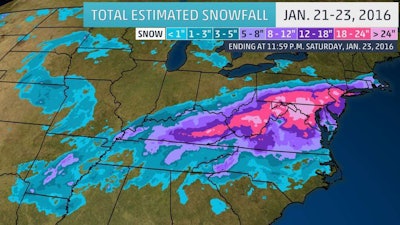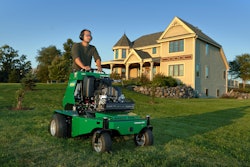 Winter storm Jonas set all-time snowfall records in Baltimore; Harrisburg, Pennsylvania; and JFK Airport in New York City.
Winter storm Jonas set all-time snowfall records in Baltimore; Harrisburg, Pennsylvania; and JFK Airport in New York City.Photo: The Weather Channel
Editor’s note: This article was written by Borsello Landscaping, a full-service lawn and landscaping company that has served the Delaware, Maryland and Pennsylvania area for more than a decade.
Delaware-based landscaping design company Borsello Landscaping was recently in the middle of the massive winter storm system “Jonas” – along with millions of other residents who found themselves buried in snow. Customers have already asked how they can protect their homes against the onslaught of snow and cold weather, and how they can prepare their homes and yards against any future inclement winter weather.
Jonas spread over 12 states on the N.E. coast, with many cities seeing two to three feet of snowfall in just a couple days. The storm extended along a 1,000-mile path from the Mississippi River up to southern New England. Virginia Gov. Terry McAuliffe was the first to declare an official State of Emergency warning on Thursday, Jan. 21, 2016, while Washington D.C. and New York City both became abnormally quiet. Meteorologists in Delaware estimated that Jonas dropped around 12 to 18 inches of heavy snow in the state.
As residents begin clearing out the snow and fortifying their homes for the remaining winter season, Borsello Landscaping has some simple tips for fellow landscapers to pass on to clients to help protect their gardens and backyards for spring planting:
1) Do not brush or knock ice off of plants or branches. It’s actually better to let it just naturally melt off the plants, rather than brushing it or knocking it off. Even if the limbs are already bent over or damaged, it will cause more damage trying to knock it off.
“Just like animals evolve, plants evolved to adapt to the winter,” says Amy Sassaman, marketing manager at Borsello Landscaping. “Your foliage has grown tolerant to ice and snow, and you will usually end up causing more permanent damage than the ice will.”
2) Rock salt is effective for melting ice, but it’s important to choose the correct kind of salt to protect landscaping. Always read the label to make sure the ice melt is concrete, stone, brick, and pavement safe; many kinds of sidewalk salt can be harmful to walkways, causing all kinds of trip and fall hazards once the snow melts.
3) Instead of spreading rock salt, many public works crews brine roadways with a saltwater solution, while others prefer to use calcium magnesium acetate as a deicer.
4) For brand-new pavement or walkways, residents can simply place a tarp over the area before ice forms.
5) If homeowners are concerned that certain trees or plants in their yard are not suited for colder temperatures, then they can protect the roots against “winter burn” by adding an extra layer of mulch to gardens before a big storm hits.
6) Finally, safety should always be a top priority. Depending on how big the storm is and how much snow falls, it may help to clear some snow during the storm instead of after. However, if it’s too cold or windy, it’s best to stay inside and wait for the entire storm to pass before clearing patios, walkways or driveways.











